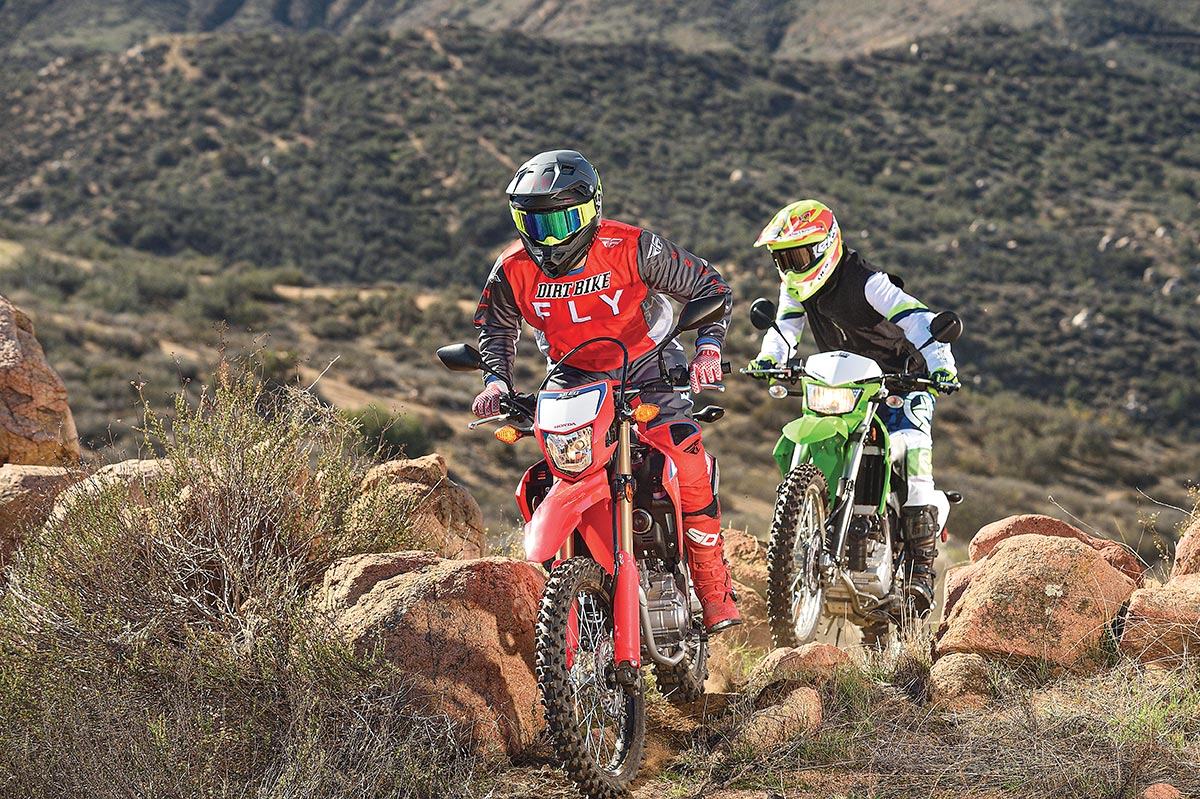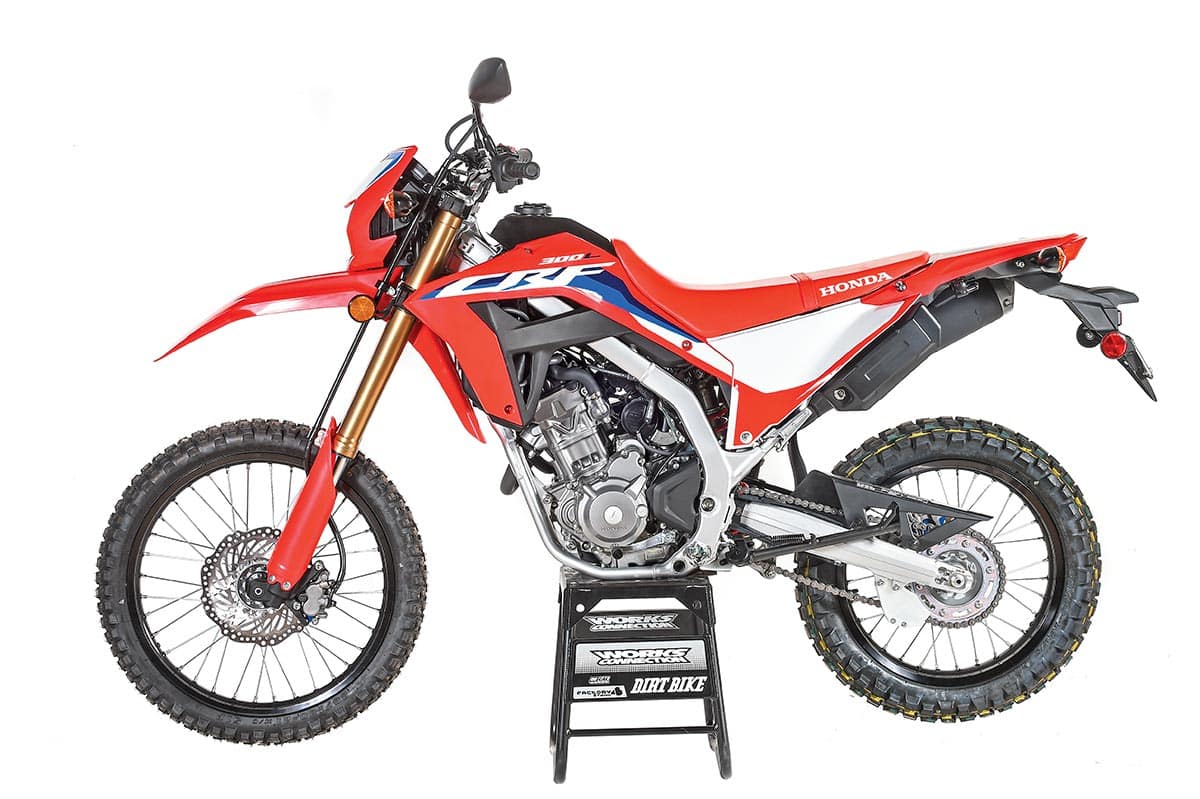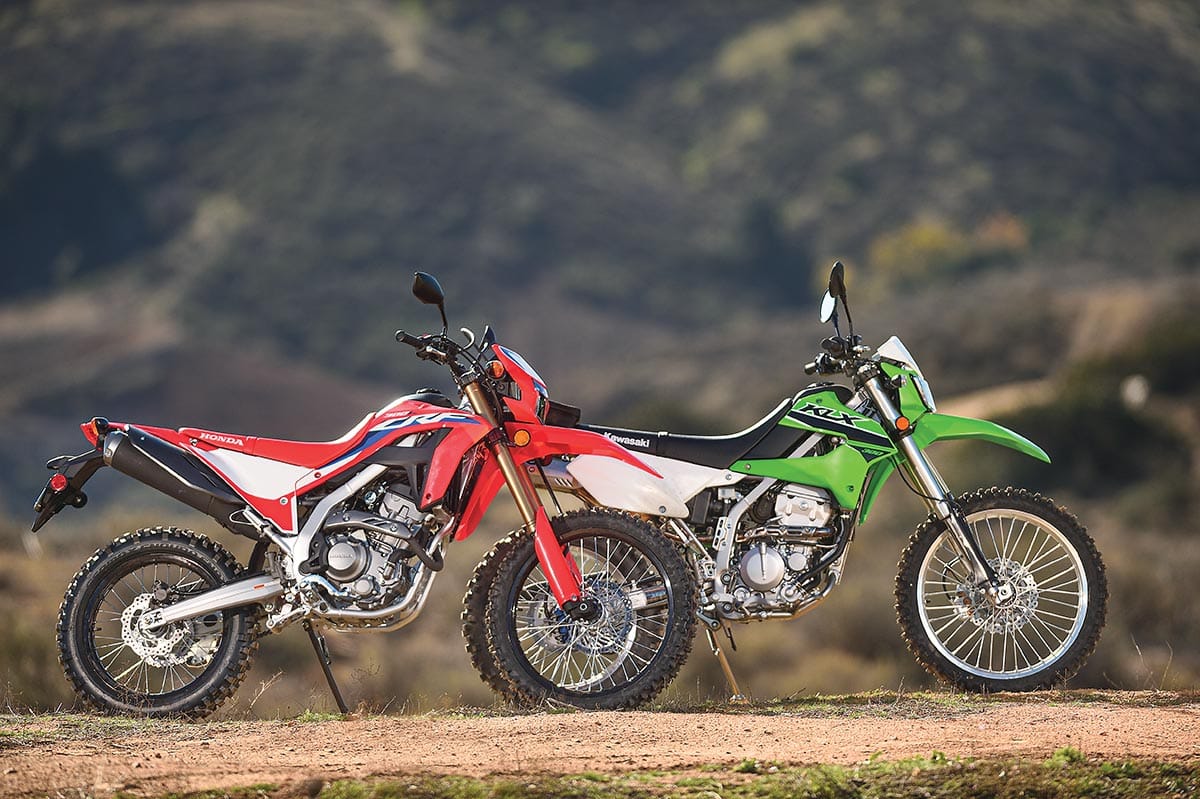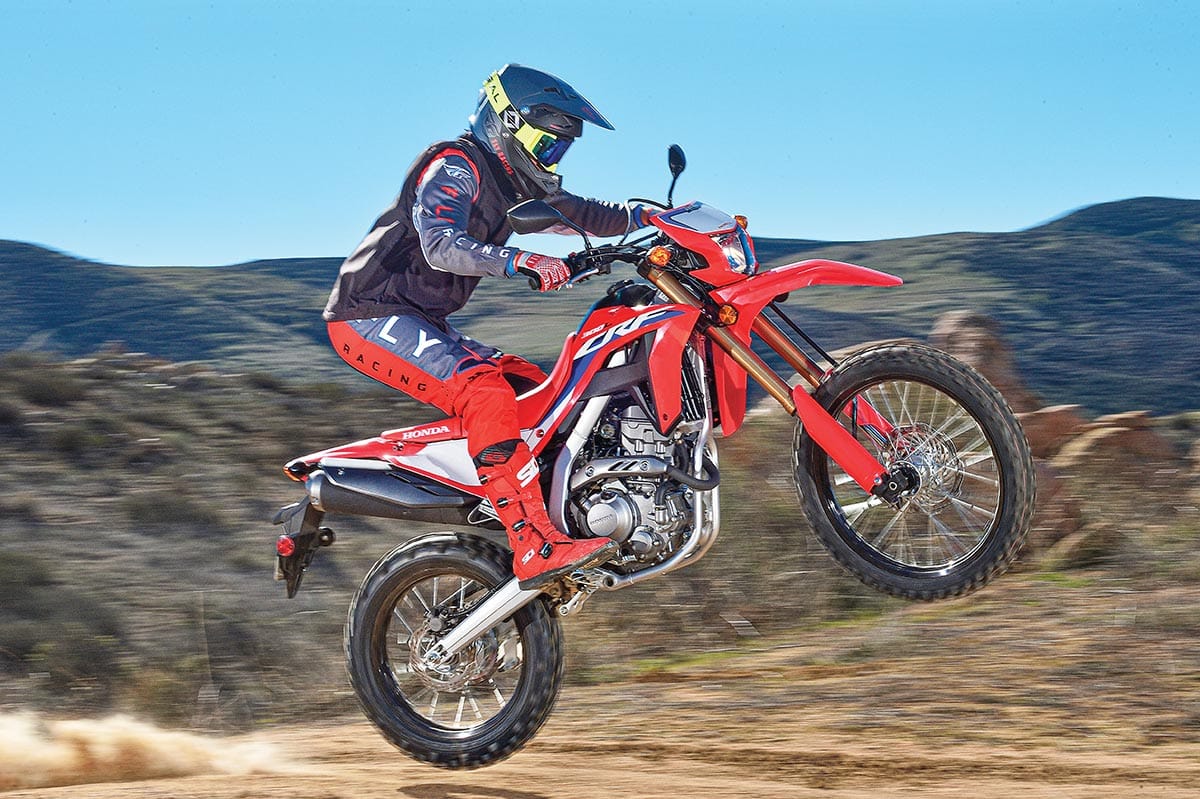The biggest shortcoming for most modern motorcycles has nothing to do with suspension, handling, horsepower or engine type. It’s price. In 2005, the best dual-sport bikes you could buy cost around $5400. Today’s versions are faster, lighter and have far better suspension, but they sell for almost $13,000. Is that really progress?
The 300s from Honda and Kawasaki exist specifically to combat that issue. They both sell for around $5500. For that price, there are some things you don’t get, but you probably get more than you expect.


HONDA CRF300L
On paper, the Honda CRF300L sounds just as sophisticated as any motocross bike. It has an electric-start, double-overhead-cam motor with four valves and fuel injection. But, it was designed with price in mind right from the start. The assembly is performed at Honda’s plant in Thailand. This bike first appeared as the CRF250L back in 2013, then it got a major update in 2021. The stroke was increased by 8mm to arrive at 286cc. It got new camshafts, and both the airbox and the exhaust were redesigned. The clutch was redesigned as well, with a feature that Honda calls “slip assist.” This acts like a slipper clutch to reduce engine braking and uses engine torque for a kind of a power-assisted clutch pull. The CRF300L has a six-speed gearbox with sixth acting as a very tall overdrive.
When you just walk around the bike, you don’t get the impression that Honda cut corners anywhere. The finish is outstanding, and all the parts look topnotch. The brakes are made by Nissin, and the rims are aluminum. You have to get up close to see the inexpensive stuff. The suspension is about as basic as possible. The rear has adjustable spring preload, and that’s all; there is no reservoir, and there are no clickers. The handlebar is 7/8-inch steel, and there are no handguards or frame guards. One key area where the budget nature of the CRF300L is undeniable is weight. It comes in at 286 pounds without fuel.
KAWASAKI KLX300
The Kawasaki KLX300 has a very different backstory. It has been blinking in and out of existence since 1994. At that time, it wasn’t designed as a budget dual-sport bike at all; it was one of very few off-road four-strokes. As for technology, it was miles ahead of the Honda XR250R and the Suzuki DR250 of the day, which were both single overhead cam and air-cooled. The off-road version of the KLX got punched out to 292cc in 1997, then went mostly unchanged for 10 years before being quietly dropped. Its life as a dual-sport started in 2006. The displacement was back to 250cc, and it got electric start. That bike lasted until 2014. Next up, a 2018 version showed up with fuel injection. The version of the bike you see today came to life in 2021 when the displacement was upped to 292cc.
Back in the day, the Kawasaki KLX250 was manufactured in Japan. Today, it’s made in Kawasaki’s Thailand plant; no surprise there, but it looks like it was built with the same tooling, especially where the steel perimeter frame is concerned. It’s pretty much the same as it was in 1994. One area where Kawasaki splurged was in suspension. The fork has adjustable rebound damping, and the piggyback shock has adjustable preload, rebound and compression damping. On our scale, the Kawasaki is 282 pounds without fuel.
WALK AROUND
Clearly, Kawasaki and Honda have been watching each other closely. Both bikes have similar, if not identical, specs. In this market, seat height is a big deal. Both bikes are taller than you might expect. With unladen suspension, the lowest part of the Kawasaki’s seat is 36.5 inches. The Honda’s is 37.2. That changes as soon as the bikes settle under their own weight. They’re soft, very soft. The Kawasaki settles more than the Honda, making it a little easier for the short-inseam crowd to touch the ground. Conversely, the Honda has more ground clearance.
You can tell the Kawasaki was conceived in an earlier time. It looks decidedly more old-school than the sleeker Honda. The Kawasaki’s frame looks a little more cobby, and the bodywork is straight out of the Ricky Carmichael era. For the most part, that’s just cosmetics. Where the KLX’s narrow footpegs are concerned, though, it’s painfully behind the times. The Honda has more or less modern pegs that wouldn’t be out of place on a current motocross bike.
Both bikes come with very street-oriented tires. In order to go on an off-road ride of any substance, you need to replace them with full knobbies. We installed Dunlop’s new Geosport EN91 tires, which are knobbies with DOT approval.


OFF-ROAD SHENANIGANS
Up front, you gotta understand what these bikes are. They were made for street transportation and mild trail riding. If you think you’re going to beat up on your buddy’s 300 two-stroke, you’re just delusional. One on one, though, they’re great trail companions. Their performance is so similar that you can’t help but have fun—just don’t invite those other guys. They both make around 23 horsepower and rev out around 9500 rpm. That’s enough power to go respectably fast on level, hard-packed trail. When you get into sandy hills, they struggle. You quickly discover that you have to shift like a madman. If you try to stretch a gear by abusing the clutch, both bikes fall flat.
If you really pay attention, you discover that the Honda has slightly more low-end power. It’s also geared lower in first and second gear—that’s where you spend almost all your time. First gear maxes out around 28 mph on the Honda and 30 on the Kawasaki. Both bikes could use lower final gearing and be happier on the trail. In the big picture, though, the motor performance on these two bikes is so similar it’s almost eerie.
A much more relevant difference between the two is the seat height. Not only is the Honda a little taller, but it has a wider seat. That means short riders are really going to struggle just to get a leg over it. Then, when they get into a situation where they have to paddle, the CRF can be intimidating, especially for beginners. The Kawasaki gives you an extra inch or so of inseam. Riders who are taller and those who are more experienced, on the other hand, will welcome the Honda’s extra ground clearance. It isn’t just about clearing rocks and stumps, it’s about how close your feet are to the ground. On the Kawasaki, you’re nervous about wiping your feet clean off those narrow little footpegs.

There’s a much bigger issue when it comes to suspension. Neither bike is set up for real off-road riding. They’re made to be cushy and comfortable for a ride around the campsite, nothing more. That, more than any other factor, limits off-road performance. The ride that feels so plush on the road turns into a pitchy, divey affair in even the mildest off-road terrain. In the case of the Kawasaki, you at least have the option of subtle fine-tuning. You can increase preload on the rear shock and increase both compression and rebound damping. That gives you a little more security, but the range of adjustability is limited. The Honda, on the other hand, has no adjustability and desperately needs more damping at both ends. The rear shock on our test bike came with the preload adjuster backed all the way out. The knee-jerk reaction would be to crank it down, but that would only make the lack of damping more of an issue. Suspension improvement gets expensive fast. Race Tech sells the GS-3 shock for around $850. Up front, you might be able to get away with a stiffer spring (there’s only one in the Honda fork) and thicker oil, but beyond that, it’s easy to spend a grand in a hurry. Exhaust systems are available for both bikes, too, expect to pay around $600 for something like a Yoshimura slip-on. In order to get the most from that, you would need a fuel modifier like a Dynojet Power Commander (another $300). You can improve both bikes, but it defeats the purpose. It’s all about the price, remember? The solution is simply to stay within your limits. No one said these were race bikes.
ADVICE AND COUNCIL
Our advice is to focus on what these bikes do well. They both start easily, run cleanly and are virtually vibration-free. They both have excellent brakes; the Honda is even available with anti-lock brakes for an additional $300 if you want. If you have no more than $6000 to spend and you want to ride, either of these bikes is a gift from heaven. Between the two, we believe the Kawasaki is the best entry-level bike because of its smaller size, shorter seat height and better suspension. More experienced riders might be drawn towards the Honda because of its better low-end power, but its under-damped suspension more or less cancels that out. It’s a close call in either case and underscores how closely Honda and Kawasaki were looking at each other when these bikes were developed.
At the end of the day, the Honda and Kawasaki 300s are either stepping stones leading to more extensive investment in the motorcycle world or a final destination for passive involvement. They play both roles well, and the motorcycle world needs them more than it needs anymore $13,000 super dual-sports.





Comments are closed.